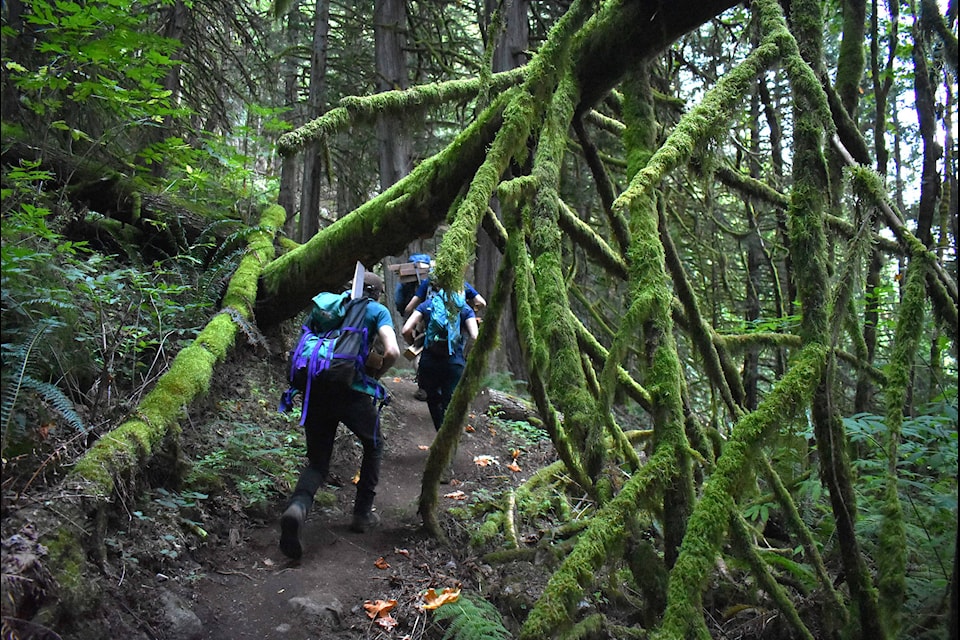The smell of cedar is still wafting up from freshly constructed walkways and steps as Hope’s trail crew finished their final day working on a new hiking trail Sept. 3.
Kelly Pearce, trail builder and director for Hope Mountain Centre, said cedar is the preferred wood to use in trail building as it is rot resistant and lasts much longer. The Silver Creek trail, tentatively named Kw’okw’echíwel Stl’áleqem (Lookout of the Two-Headed Serpeant in Halq’eméylem), is the first trail the Hope Mountain crew have constructed from scratch as all of their previous trail builds were along existing routes.
Originally an area traversed by Sto:lo hunters and travellers, the circa three-kilometre winding route up from Silver Skagit Road to a lookout over Hope lay dormant until local resident Justin Brown started scouting out a route to reach the summit. Brown, an avid outdoor enthusiast, began bushwhacking his way up a route which the new trail follows.
The trail hugs the hillside and hikers will be treated to a view of the adjacent Hope Mountain and Wells Peak as they encounter alternately relaxing flat sections and steeper climbs. At designated lookout points, benches are set to be constructed and arborists will also be employed to remove the lower branches off of select trees to further open up these views.
The trail eventually leads up to a summit, with a loop option, through pockets of old growth forest with trees in the five-to-700-year range.
The three-person trail crew, led by crew leader Rebecca Arrowsmith together with Angus Stromquist and Nic Kamp, have been spending 10 hour days Monday to Thursday since the start of July to construct the trail.
They began by hacking into the earth with pulaski tools, which combine an axe and an adze in a single head. With these, the crew dug a two-foot wide trail and removed rocks and roots along the way.
“It’s a lot of lower-to-mid back pain,” Pearce commented, which even the younger members of the crew were experiencing.
They continued, section by section, to flatten and widen the trail. “Depending on how steep it was, we would put in stone steps or box steps or some kind of stepping device,” Arrowsmith said.
They skipped the steeper, hairier sections of the trail, coming back around later to install switchbacks and drill into granite rock walls to install rebar that will eventually hold log retaining walls.
It’s not your average 9-to-5 job. Yet the trail crew said they’re happy to weather the occasional ground wasp attack, Stromquist has so far been spared but the others haven’t been so lucky, to do this work. It’s Nic Kamp’s first year on the crew, and so far he said it’s been ‘amazing’ even after having been stung 20 times by angry wasps.
“It’s just getting outside. I like being outside, better than indoors,” he said. “And it’s surprising (with) how close we are to town, it’s so quiet and peaceful.”
Volunteers have also lent their time to the trail’s construction, building the first portion of the trail and lugging cedar for the trail crew. Before next spring, when Pearce hopes the trail can open, a parking area and path from the trailhead up first need to be constructed. Logging in the area also needs to be wrapped up by then.
Sto:lo history is alive and well on this trail, and part of the work before next year involves determining how best to represent this history.
Archaeological work has found evidence of Sto:lo hunters and travellers moving through the area as far back as 2,300 BCE, including evidence of tool making and ancient fire pits. Archaeological evidence was also found on the summit of the trail, which was likely used as a defensive lookout to watch for groups coming up the Fraser River to raid villages.
Some areas will have interpretive signage up, such as the Stone Garden where the history of the Sto:lo people is combined with evidence of glaciers advancing down the granite rock faces.
Yet pointing out where exactly Indigenous history lives is a tricky balancing act, Kelly explained, as too much detail about specific sites could draw the wrong kind of interest.
“Unfortunately there are unscrupulous history hounds who go around with metal detectors and all kinds of stuff, and dig up debitage and arrowheads,” he said. “When they know that there’s a dedicated archaeological site they’ll come there looking for goodies for their collection.” How this history will be displayed on trail will be determined together with the archaeologists and historians involved.
Kelly said getting approval for the use of the trail’s name from local First Nations is also in the works, a name originally suggested by Sto:lo cultural historian Sonny McHalsie.
Do you have something to add to this story, or something else we should report on? Email:
emelie.peacock@hopestandard.com
